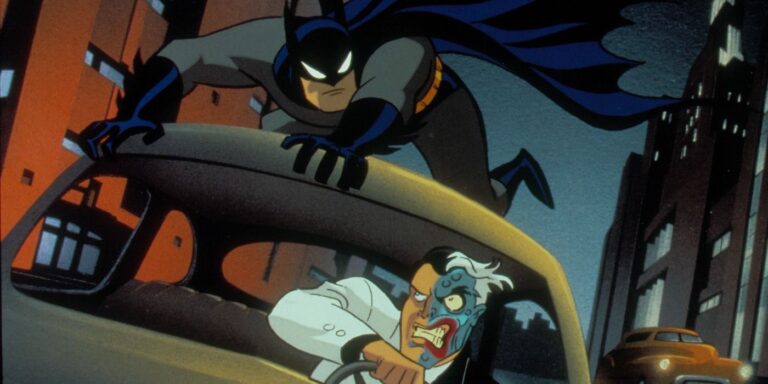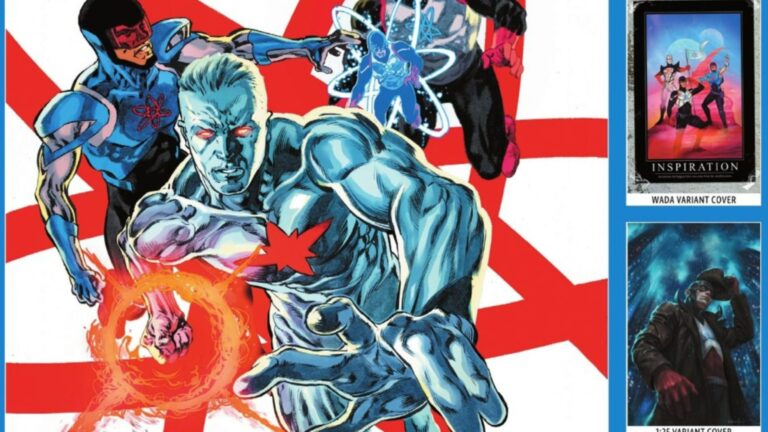The DCAU That Existed Before JLU
Way back in the final years of the 20th century, DC Comics dominated television screens with the now legendary Batman: The Animated Series and Superman: The Animated Series, both of which were produced by Bruce Timm and Warner Brothers Animation. The cartoons received their own comic book spinoffs, and in 1997, The Batman Adventures comic had just relaunched as the Batman & Robin Adventures alongside its sister series Superman Adventures. These books were meant to occur in the same continuity as the shows, so the interior art was designed to reflect the popular animated style. The only thing missing was the rest of the DC Animated Universe.
That’s where Adventures in the DC Universe came in. No longer would the more kid-friendly corner of comics be relegated solely to the recognizable versions of Batman and Superman from TV, but the wider universe of DC characters was welcome to feature as well. At a time when The Flash, Green Lantern and Aquaman had yet to make their guest appearances on Superman: The Animated Series, not to mention the entirety of the 2001 Justice League animated series, it was a big deal to see these characters in this visual aesthetic.
.jpg)
10 Best Batman Comics Set In The DCAU
Taking place in the DCAU, some of Batman’s greatest comics let readers further explore everything they love about Batman: The Animated Series.
The New Batman Superman Adventures Enters the DC Universe
The Animated Series Became Part of a Bigger Universe
Adventures in the DC Universe ran for 19 issues with one annual, the majority of which was written by Steve Vance with art by John Delaney, whose cover art for Issue #1 became an instant classic. It depicted the popular Timm versions of Batman and Superman against a backdrop of characters that reflected the late ’90s landscape of DC Comics, many of which had never been seen in animation before — at least, not since the days of Hanna-Barbera’s Super-Friends.
Writer Steve Vance made a name for himself on
Bongo Comics
with Matt Groening and won the Eisner Award for Best Writer on 1993’s
Simpsons Comics #1
.
Aquaman had his beard and hook hand from the Peter David run. Green Lantern was Kyle Rayner, who wore his signature “crab mask.” The cover even featured several characters that would never appear on-screen in the DC Animated Universe, like Plastic Man, Power Girl, Ted Kord’s Blue Beetle, Black Lightning, Connor Hawke’s Green Arrow and the Phantom Stranger.
Although the Joker is clearly peeking out from the back right corner, Delaney clarified that it was intended to be The Creeper, aka Jack Ryder, but miscolored as the Clown Prince of Crime instead. Therefore, the Joker was the only villain on the cover collage among a sea of heroes, although the interior story featured an assortment of villains to challenge the JLA.
Artist John Delaney was an animator before breaking into comics and drafted storyboards for shows like
Tales of the Crypt
,
Flash Gordon
and
Teenage Mutant Ninja Turtles
.
The Justice League on these pages reflected the same lineup as the JLA comic book by Grant Morrison and Howard Porter, which ran concurrently at the time of publication. Besides the usual suspects of Batman, Superman, Wonder Woman, Aquaman and Martian Manhunter, the team also included the legacy versions of Kyle Rayner as Green Lantern and Wally West as The Flash.
Issue #1 was titled “Now You See Em…” Every time a member of the Justice League of America attempted to apprehend a supervillain, they would suddenly vanish and teleport away. A mysterious entity known only as “Cipher” shared special teleport-signal lock devices with various villains, which included the familiar faces of Scarecrow from Batman: The Animated Series and Parasite from Superman: The Animated Series, alongside Gorilla Grodd, Doctor Light, the Cheetah, Blockbuster and Major Disaster. Delaney masterfully illustrates a multipage fight sequence between each of the heroes and their accompanying rogues.
Ultimately, the villains were captured while the mastermind escaped to fight another day. “Cipher” continued to appear as a throughline story arc throughout the first year of Adventures in the DC Universe. Typically, only one or two heroes were featured in a single issue, but the JLA returned in full force for #12, which also saw the culmination and resolution of the “Cipher” plot.

9 Best Superman Comics Set In The DCAU
DC’s Animated Universe is one of the best franchises in film or television. It’s also inspired great stories and even series in DC Comics.
The Justice League Animated Series Broke This Comic Book
On-Screen Canon Overwrites the Comics
At the time of publication, the only characters from the cover of Adventures in the DC Universe #1 to appear in the fledgling DC Animated Universe included Batman, Superman, the Joker and Zatanna from Batman: The Animated Series episode of the same name, until the floodgates opened in late 1997. Superman: The Animated Series, in particular, introduced classic superheroes as guest stars alongside the Man of Steel, which expanded its storytelling potential beyond the city limits of Metropolis.
Wally West as The Flash appeared in Superman: The Animated Series episode “Speed Demons,” Doctor Fate in “The Hand of Fate” and Steel in “Heavy Metal.” The New Batman Adventures introduced Jason Blood, aka the demon Etrigan, in the 1998 episode “The Demon Within.” That same year, Superman: The Animated Series‘ third season brought the Legion of Super-Heroes in “New Kids in Town,” Kyle Rayner as Green Lantern with “In Brightest Day” in 1999, as well as an appearance from Aquaman in “A Fish Story.”

10 DC Heroes the DCAU Could’ve Done Better
The DC Animated Universe handled most characters well, but a few changes could have fixed the shared universe’s issues with other DC heroes.
None of these episodes reflected how Adventures in the DC Universe introduced the same characters in the same continuity, but the shows weren’t required to match the tie-in comics. Timm commented on their differences in a 2012 interview for Modern Masters Vol. 3:
“The comic book animated continuity is actually different than the actual animated continuity — they’ll do things that contradict what we do and vice versa.”
If the animated continuity wasn’t fractured enough, 2001’s Justice League animated series definitively broke any hope that Adventures in the DC Universe could co-exist in the DCAU canon. The arrival of Justice League established many characters’ backstories and visual designs that often contradicted the events of Adventures in the DC Universe and ultimately rendered the comic book series out-of-sync with the rest of the DC Animated Universe, both before and afterward.
Comic book artist Kyle Rayner was no longer the Justice League’s Green Lantern; military veteran John Stewart filled that slot instead. Hawkgirl was now a founding member of the Justice League, which dropped the “of America” from its name in favor of a more universal outlook. J’onn J’onnz was almost never referred to as the Martian Manhunter, Wonder Woman didn’t work at the Gateway City museum, and the rest of the League possessed drastically different visual designs than simply recycling what was previously established in The New Batman Superman Adventures.
When Justice League was retitled Justice League Unlimited for its third season in 2004, the storytelling expanded its reach into the furthest corners of the DC Universe. Throughout the remainder of the show, just about every other character from the Adventures in the DC Universe #1 cover was eventually introduced, including but not limited to Captain Atom, Black Canary, The Ray, Booster Gold, Shazam, Deadman and Hawkman.
But just because a comic book doesn’t fit snugly into the continuity of its source material doesn’t mean that it can’t be an enjoyable read. In fact, the sheer existence of Adventures in the DCU is a joy in itself, simply to experience the DC Universe in its entirety as depicted in the classic Timm style.

10 DCAU Originals That Leaped into Comics Canon
In addition to character-defining portrayals of iconic DC heroes, the DC Animated Universe also brought many original creations to the table.
Adventures in the DC Universe #1 may not have the most complex of plots, but the series excels in its initial intention to be an all-ages entryway into the broader DC Comics pantheon. Vance and Delaney could never have known that Justice League Unlimited would exist several years later and usurp its position as the definitive depiction of the animated DC Universe.
Any fans of Batman: The Animated Series, Superman: The Animated Series and Grant Morrison and Howard Porter’s run on JLA will find the nostalgia levels cranked all the way to maximum capacity within the pages of Adventures in the DC Universe. Even almost three decades later, the book remains a delight to experience what could have been for a fan-favorite era of DC characters.









